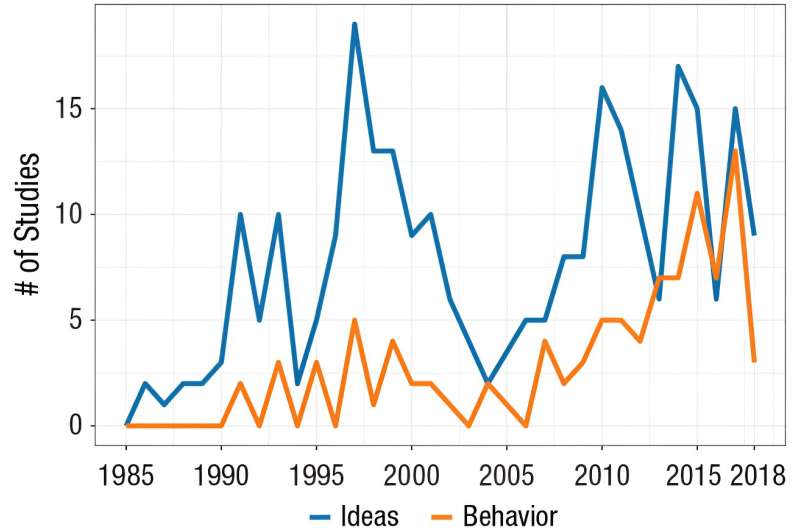This article has been reviewed according to Science X's editorial process and policies. Editors have highlighted the following attributes while ensuring the content's credibility:
fact-checked
peer-reviewed publication
trusted source
proofread
Programs to prevent sexual violence show no evidence of curbing assaults, analysis finds

Sexual violence prevention programs effectively change ideas and beliefs that underscore assaults, but show no evidence of reducing their actual occurrence, a new comprehensive analysis shows.
The findings are published in Psychological Science in the Public Interest.
Researchers led by behavioral scientist Roni Porat of Hebrew University challenge the assumption that changing people's thoughts about sexual violence will change their actual behavior. They call on scientists to study more behavior-centered approaches to reducing sexual assaults.
"The prevailing model for how to go about reducing sexual violence does not appear to be a fruitful one," the authors report. "Unfortunately, we do not have strong evidence to suggest that changes in attitudes, norms and beliefs that result from the tested interventions have positive downstream consequences for preventing perpetration."
Porat's co-authors include APS Fellow Betsy Levy Paluck of Princeton University, social psychologist Ana Gantman of Brooklyn College (CUNY), and researchers Seth Ariel Green of Princeton, and John-Henry Pezzuto of University of California, San Diego.
The researchers gathered data from 331 scientific evaluations of sexual-violence prevention interventions. The studies, spanning more than three decades, occurred in various settings, including college campuses, high schools and middle schools and workplaces.
Nearly 90% of those studies were conducted in the United States, with the rest occurring in Canada, Europe, Israel and Africa. About 67% of the studies involved interventions targeting both men and women. Nearly every program studied centered on what people believe about sexual violence, including what constitutes sexual violence and what they can do to stop it.
"For example, rape myths, like 'some women say no when they mean yes,' are a very frequent target of intervention," the authors say.
The researchers examined studies on programs that educate men on the gravity of sexual violence, and adolescents about dating violence and relationship skills. They also noted a rise over the years in programs designed to encourage bystanders to stop acts of sexual violence (e.g., speaking against sexist or violent language, walking an intoxicated friend home).
Less than 20% of the studies analyzed included measures of behavior following the interventions. Many of those studies involved asking participants about sexual behaviors or bystander behaviors.
Although the analysis showed that intervention programs helped increase knowledge about sexual violence and empathy and support for victims, none led to meaningful changes in rates of sexual assaults.
"We find that existing sexual violence interventions are indeed effective for changing ideas like rape myth acceptance, but not for changing behavior—the ultimate goal of any prevention intervention," the authors said.
The authors suggest more research evaluating the impact of geographic or environmental measures, such as the creation of communal spaces that make it difficult for perpetrators to victimize someone.
"We hope to spark creativity," Porat and colleagues said, "to get people thinking beyond approaches that seek only to change what is in people's heads and hope that changed behavior will follow."
In a commentary accompanying the report, Elise C. Lopez and Mary Koss, University of Arizona scholars who study sexual violence and its prevention, implore researchers, educators and public policymakers to reevaluate the basic tenets that underscore existing prevention programs. They also suggest K-12 education prevention programs include practical behavioral skills for having consensual sex.
"Progress will be stifled," they argue, "until public policy, public opinion and funding mechanisms catch up to a shift in thinking about the fundamental assumptions of effective prevention."
More information: Roni Porat et al, Preventing Sexual Violence: A Behavioral Problem Without a Behaviorally Informed Solution, Psychological Science in the Public Interest (2024). DOI: 10.1177/15291006231221978
Elise C. Lopez et al, Comment on Porat et al. (2024): "Preventing Sexual Violence: A Behavioral Problem Without a Behaviorally Informed Solution", Psychological Science in the Public Interest (2024). DOI: 10.1177/15291006241238640
Journal information: Psychological Science in the Public Interest
Provided by Association for Psychological Science





















